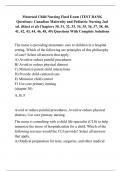Maternal Child Nursing Final Exam (TEST BANK
Questions- Canadian Maternity and Pediatric Nursing 2nd
ed. (Ricci et al) Chapters 30, 31, 32, 33, 34, 35, 36, 37, 38, 40,
41, 42, 43, 44, 46, 48, 49) Questions With Complete Solutions
The nurse is providing atraumatic care to children in a hospital
setting. Which of the following are principles of this philosophy
of care? Select all answers that apply.
A) Avoid or reduce painful procedures
B) Avoid or reduce physical distress
C) Minimize parent-child interactions
D) Provide child-centered care
E) Minimize child control
F) Use core primary nursing
(chapter 30)
A, B, F
Avoid or reduce painful procedures, Avoid or reduce physical
distress, Use core primary nursing
The nurse is consulting with a child life specialist (CLS) to help
minimize the stress of hospitalization for a child. Which of the
following services would the CLS provide? Select all answers
that apply.
A) Medical preparation for tests, surgeries, and other medical
,procedures
B) Support before and after, but not during, medical procedures
C) Activities to support normal growth and development
D) Grief and bereavement support
E) Emergency room interventions for children and families
F) Only inpatient consultations with families
C, D, E
Activities to support normal growth and development., Grief and
bereavement support, Emergency room interventions for
children and families
The nurse is implementing interventions to prevent physical
stressors for a 9-year-old child receiving chemotherapy in the
hospital. Which of the following is an example of using
atraumatic care for this child?
A) Use restraint or "holding down" of the child during the
procedure to prevent injury.
B) Have the parent stand near and/or rub the child's feet during
the procedure.
C) Insert a saline lock if the child will require multiple doses of
parenteral medications.
D) Avoid using numbing techniques for multiple blood draws or
IV insertion.
C) Insert a saline lock if the child will require multiple doses of
parenteral medications.
,The nurse contacts a child life specialist (CLS) to work with
children on a pediatric ward. What is the primary goal of the
CLS?
A) Decrease anxiety and fear during hospitalization and painful
procedures
B) Keep children who are hospitalized distracted from pain
C) Perform medical procedures using atraumatic principles
D) Act as a liaison between the nurse and the child
A) Decrease anxiety and fear during hospitalization and painful
procedures
The nurse is preparing a child and his family for a lumbar
puncture. Which of the following would be a primary
intervention instituted by the CLS to keep the child safe?
A) Distraction methods
B) Stimulation methods
C) Therapeutic hugging
D) Therapeutic touch
C) Therapeutic hugging
The child life specialist (CLS) is preparing a 6-year-old child for
a magnetic resonance imaging (MRI) scan. Which of the
following statements reflects the use of atraumatic principles
when explaining the procedure?
A) "You will be taken to a magnetic resonance imaging machine
for an x-ray of your
liver."
, B) "You may hear some loud noises when you are lying in the
machine, but they won't
hurt you."
C) "You have nothing to worry about; the MRI machine is safe
and will not cause you
any pain."
D) "Let's just get you to the x-ray department for your test and
you'll see how simple it
is."
B) "You may hear some loud noises when you are lying in the
machine, but they won't
hurt you."
The nurse uses family-centered care to care for children in a
pediatric office. Upon what concept is family-centered care
based?
A) The family is the constant in the child's life and the primary
source of strength.
B) The care provider is the constant in the child's life and the
primary source of
strength.
C) The child must be prepared to be his or her own source of
strength during times of
crisis.
D) The wishes of the family should direct the nursing care plan
for the child.




